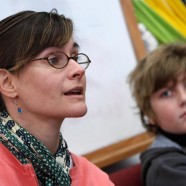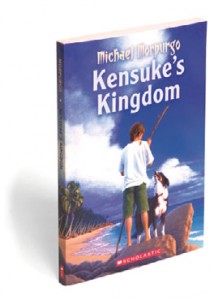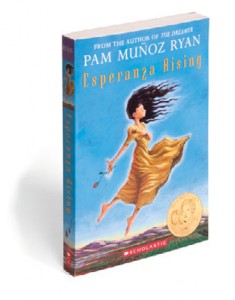
Grappling with the experience of a fictional character often opens doors for readers. A close range, intimate look at a character’s challenges and decisions can aptly teach about perspective. Jenn Katsoulis’s fifth-graders not only consider writing styles and develop analytical skills as they study literature. Through the books that she and librarian Joan Eisenberg choose, Jenn aims to help students look at the world from another person’s point of view. “I choose books that force the reader to do that,” Jenn says. Book by book, her fifth-graders increase their sophistication and awareness about the many ways to live a life.
Joan helps Jenn select contemporary fiction, whose protagonists are the same age as her students, and together they develop curriculum surrounding the stories. They add selections beyond the young adult classics Bridge to Terabithia and Tuck Everlasting. They include writers whose work highlights worlds, events, and personal challenges that broaden a fifth-grader’s cultural awareness. The students necessarily witness and come to grips with how young people different from themselves manage their separate challenges.
What are Milton’s fifth-graders reading, and why are these selections effective?
 Kensuke’s Kingdom by Michael Morpurgo
Kensuke’s Kingdom by Michael Morpurgo
In this survival story, young Michael is washed up on a Pacific island with his dog, Stella. He struggles to survive on his own— unable to find food and fresh water. When things are at their worst, Michael realizes that he and Stella are not alone. Fellow castaway, Kensuke, has lived on the island since the bombing of his native Nagasaki. Slowly, the two become part of each other’s world—teaching and learning from one another.
“The students adore this book,” Jenn says. “Across a cultural divide and generations, the characters restore one another, and come to depend on one another. In class we ask, ‘How would you survive? What would you do in this situation?’”
All of the Above by Shelley Pearsall
Based on a true story of inner-city students in Cleveland, four seventh-graders at Washington Middle School decide to put their school on the map by building the world’s largest tetrahedron. They are out to prove that—despite the faded, crumbling façade of their school building—smart, ambitious and capable students are inside. “The story is told from four points of view, and though the characters are from the same school, and similar situations, my students quickly recognize the four distinct voices and perspectives,” Jenn says. “They then appreciate, even more, the characters’ working together for a common goal.”
 How to Steal a Dog by Barbara O’Connor
How to Steal a Dog by Barbara O’Connor
Georgina Hayes and her family have just been evicted from their apartment, and they’re struggling to make ends meet. They find themselves having to live out of their car, although no one at school knows. When Georgina sees a missing-dog poster offering a $500 reward for its safe return, she realizes that “borrowing” the right dog may be the answer to all of her family’s problems. “The story is about making moral decisions in desperate situations,” Jenn says. “The character is struggling with these decisions, and the students have interesting and thoughtful discussions about her challenge. The book also enlightens them: they may not know everything about a person’s individual situation.”
Faith, Hope and Ivy June by Phyllis Reynolds Naylor
Ivy June and Catherine are girls from different parts of Kentucky, participating in a seventh-grade exchange program. The girls will stay at each other’s homes, attend school together, and reflect on their experience in their journals. Catherine and her family have a fancy home with plenty of space. Ivy June lives in a small, crowded house, and her grandfather works in the coal mines supporting the family. As the girls get closer, they discover they’re more alike than different.
“This book explores the feelings that go with entering new situations,” says Jenn. “It’s about family and the assumptions we make about someone. It’s also about inner-reflection—both the characters, and my students reading the book, keep journals.”
Joey Pigza Swallowed the Key by Jack Gantos
Joey Pigza can’t sit still. He can’t pay attention, he can’t follow the rules, and he can’t help that—especially when his medication wears off. Joey has been diagnosed with ADHD. Although he tries to do the right thing, his actions often have the opposite result. Written from Joey’s perspective, the book helps children understand their peers who live with that diagnosis. It can also help a child with ADHD realize that he or she is not alone.
Jenn’s students delve deeply into Joey’s character, and how the author teaches us about Joey. “We ask, ‘What did that situation look like from Joey’s point of view? From the other characters’ points of view? Where do those views intersect?’” As they read, Jenn’s students mark Joey’s thoughts, actions and others’ reactions to him with different-colored notes, recognizing how the author shows us who Joey is.
 Esperanza Rising by Pam Muñoz Ryan
Esperanza Rising by Pam Muñoz Ryan
Esperanza Ortega’s family owns a successful ranch and a beautiful home in Aguascalientes, Mexico. When a tragedy shatters that life, Esperanza and her mother must flee to California and settle in a Mexican farm labor camp. There they confront the challenges of hard work, acceptance by their own people, and economic difficulties brought on by the Great Depression.
“Through these characters we reflect on their historical context—what was the Great Depression? What did it mean for people’s lives? My students could choose how to present their final project on this book—some composed and performed music, drew illustrations for the book, or wrote a story about what happened in Esperanza’s life five years later.”
After reading All of the Above, Jenn’s students wanted to build a tetrahedron, each side representing one of the main characters. When they finished Kensuke’s Kingdom, they felt compelled to create metaphoric recipes for things like “kindness” and “perseverance.” Since students write many essays over the year, Jenn likes to broaden their creative options when they are reflecting on the books.
In both large and small discussion groups, students talk about the decisions the characters made, what they would have done in those situations, and sometimes about events in their own lives when they’ve felt the way the characters do. “The situations our characters face are very true-to-life. There isn’t always an obvious answer, or an obvious decision to be made. The students really have to think—they consider the points of view of the characters, or people they know who are in some ways like the characters.
“By fifth grade, the students are good listeners and they’re sophisticated enough to say, ‘I agree with Jack, but I also think…’ They’ll also say, ‘In this book, I learned that you can’t judge a book by its cover.’ The students probably haven’t internalized that idea yet. However, it’s a start. The idea will resonate with them on some level. It’s a way to get their mind starting to think about those things.”
EEH



